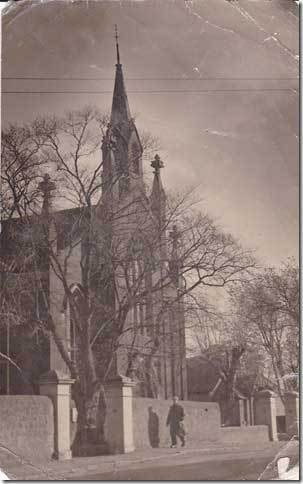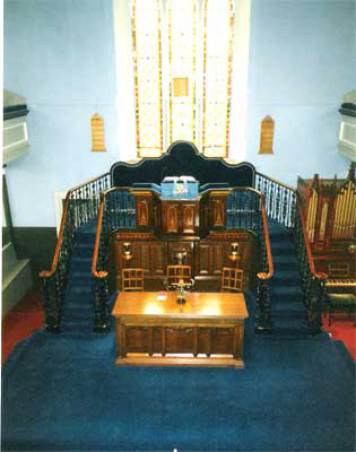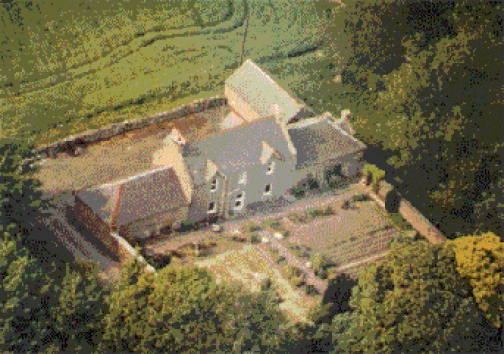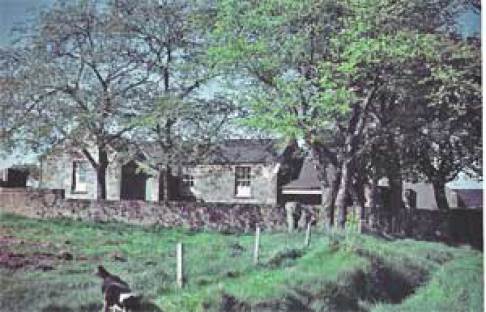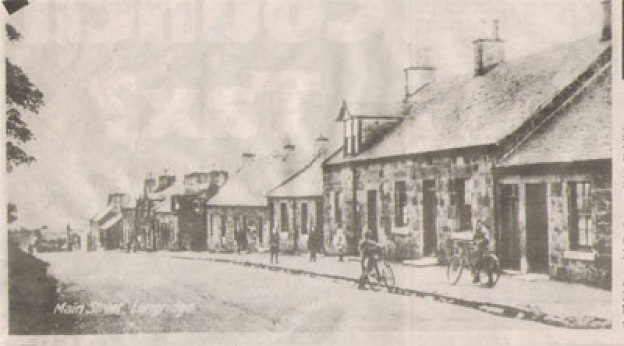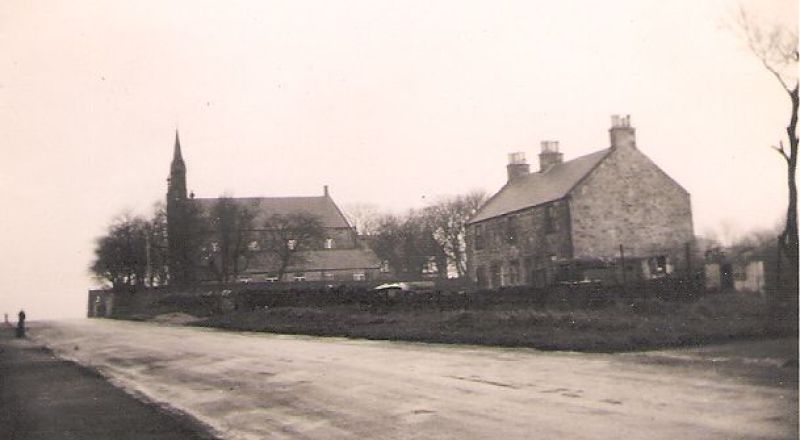
A brief historical account of longridge church
We give a sketch of the front entrance and side view of the United Presbyterian Church, Longridge, Whitburn, which was formed in the year 1772. The late Rev John Brown was the first minister of the
church, who by his eloquence and zeal, attracted a large congregation. He was born at Haddington on 24th of July 1754, and was ordained at Longridge in may 1777. Mr. Brown was a most venerable
minister, one who served God in his spirit in the Gospel of his son for over fifty four years, taking his full share of evangelistic work at all times, and even when an old man he rode to Perthshire
and preached at Balaguard, Aberfeldy, Killin,and Glenlyon. His memory is cherished in many a highland home on hill and glen to this day. Mr Brown passed away on February 10th 1832 in the 78th year of
his age and the 55th year of his ministry. The Rev William Millar was next ordained to the pastorate of the church in 1832. He was a most eloquent preacher, and was universally respected and much
loved by the congregation and was held in high esteem in the district around. During his ministry of about twenty years the second church was built. Mr Millar, through feeble health, left in 1852,
but afterwards improved in health and was appointed to the charge of a mission church in Glasgow, where he remained to his death. He was succeeded in the ministry at Longridge by Rev James Ronaldson,
who was ordained in 1854. By his pulpit and pastoral work he soon became popular in that large congregation and surrounding district. Some years after his induction a second manse was built. Mr
Ronaldson during his long ministry of about thirty two years proved himself to be a hardworking minister, esteemed in the pulpit and out of it , and beside his ministerial work he took his full share
of such public duties as fell to his lot, especially in educational work, which is still remembered with admiration, the important work he so successfully carried out , in providing school
accommodation in the large session house, and in raising the necessary funds in various ways for the maintenance of an efficient staff of teachers, when the Whitburn school board closed the Longridge
public school for two years. Subsequent to the next board being appointed the school was reopened. Mr Ronaldson, through failing health, resigned his pastoral charge in 1886, and emigrated along with
his family to New Zealand. The rev. John Gibson, M.A. the present minister, was ordained to the pastorate in 1887. Everything connected to his life and work of the church under his ministry is well
equipped and carried on with earnestness and zeal. a sale of work in aid of church funds will be held in Crofthead public school on the 24th, 25th and 26th inst. This being the first assistance asked
during the history of the church it is earnestly hoped that the members of the congregation and their friends will respond to the appeal in such a way as to make the sale of work a complete success.
courier oct 19 1895
The recording of history concerning the district around Longridge begins in the 18th century. Significantly, the first major event is in relation to that central edifice of Longridge, the church. Around 1777 there was an application made and permission given to build a Kirk in Longridge. The First minister was Rev John Brown, who was to occupy the manse, Burnhead House. The manse itself was built by Alexander Waddel, with the church itself built by the generosity of James Waddel of Crofthead House
Over the years the church changed it's affiliations, originally it was a Burgher Kirk, later the church was to split into the Auld and the New Lichts. (The Kirk built in 1809 in Longridge by the Auld Lichts was later converted to houses). Later again the link was to the United Presbyterian denomination and most recently Church of Scotland.
A list of some ministers can be found by clicking here
General History
Part of the reason for the settlement at Longridge was the nearby developing industry created by the mining of ironstone and coal and also the quarrying of various materials. In 1845 a railway
between Longridge and Morningside was opened.
The old school at Longridge was the first cottage on the right, coming from Whitburn. It was built with 'public subscription, the 'Ferguson Bequest' and Government Aid' in 1860. In 1883,
Whitburn school board thought about closing this school and making the children walk to Fauldhouse or to Whitburn (About 80 children attended Longridge school at that time) However they changed their
minds and built a new school near to the present school)
The main road was of course the major artery linking Lanark and Linlithgow (today the A706). This was known as the Cleugh Road, the name coming form the Cleuch ironworks at Wilsontown.
In a map dating from around 1895/1905 Longridge is shown to have a School, Manse, United Presbyterian Kirk, Wester Longridge, Rashierigg, Curling Pond and Longridge Railway Station. At a later point
Longridge was also to have its own Gasworks and Nail Factory.
1891 -- Street lamps lit by gas
A public meeting was held in the village school a few weeks ago for the purpose of discussing what steps should be taken to improve the gloomy appearance of the place generally, but especially that
part of the main street which can not now boast of a lighted window during the dark winter evenings. It was agreed that an effort should be made to erect a few street lamps, and a committee was
appointed to carry out the proposal. The energetic committee did not content themselves with sending round the hat in the village , but appealed to friends outside. It is gratifying to say that they
have been successful in raising a sum that will enable them to purchase what lamps they believe will meet the present needs of the village. The committee are grateful, particularly to the
non-residents for helping them carry to a successful issue this attempt to enlighten, not only the villagers, but to all who pass through Longridge on a winters evening.
*****************************
Feb 1909 --- opening of the Baillie Institute Longridge
A new institute so generously gifted to the inhabitants of Longridge and district by lady Baillie of Polkemmet, was formally opened on Monday evening by Mr. R Allan, factor, Polkemmet. The opening
ceremony took place in the institute, which was crowded to the door, all the available space for sitting and standing being fully occupied. Rev John Gibson, M.A. occupied the chair, and after prayer,
appropriately referred to the meeting which he had called about a year ago regarding the idea of approaching lady Baillie to provide some place of amusement and recreation. He was authorised by them
to do so and could assure them the reply came very promptly -- so prompt did it come that he feared to open the letter, lest it should contain a refusal, but he saw from the contents of the letter
that lady Baillie had granted their request, and tonight they had the practical reply to the petition. After it was learned that lady Baillie had generously consented to provide an institute for
them, some of them were so sanguine that they thought it could not come soon enough, and would have wished for something of a mushroom growth. But things of mushroom growth were not substantial;
there was nothing of that nature about the building in which they were tonight. Everything had been carefully planed by Mr. Allan, and he was very pleased to tell them that any suggestion he had had
to make in connection with the erection of the institute were received and considered by Mr. Allan with the utmost courtesy and good grace. They had instructed him last week to send a letter of
thanks to lady Baillie, and he had to tell them that had received a very kind sympathetic, and truly Christian reply from her ladyship, in which she hoped the institute would prove to fill the place
it was intended to fill. He would not detain them further. They had here from lady Baillie a thing of beauty, which would, they all hoped, prove a joy for a long time to come. He would ask Mr. Allan
to convey their thanks to lady Baillie for this generous gift. He now called upon Mr. Allan as representing lady Baillie [applause]
November 1909 --- extension of the Longridge Baillie institute.
On Monday evening the newly extended public institute at Longridge, generously gifted by lady Baillie of Polkemmet, was opened by ex provost Gordon, Bathgate, on behalf of her ladyship, in the
presence of a good turnout of the general public. Mr Robert Allan, factor, Polkemmet, presided and Rev J. Gibson and Mr. Harry Allan were also present. It will be remembered in beginning of the year
the institute was opened, but it soon became apparent after a few weeks that the accommodation was inadequate to meet the requirements of the place, and on lady Baillie being informed of the matter,
she at once agreed that operations for the extension of the building to should be proceeded with. What was once the reading and recreation room combined has been transformed wholly into a recreation
room, in which two full sized carpet bowling tables have been placed. Communicating with the recreation room a compact little reading room and library has been erected at the rear, while lavatory
accommodation has also been added. In both rooms several pictures are hung on the walls, which enhance the neat and tidy appearance of the internal furnishings. The recreation room is a building of
about 30ft by 18ft, while the reading room measures 18ft by 14ft. The fireplaces in each room are of a chased design, and are of somewhat similar workmanship to those in Whitburn, Fauldhouse and
Harthill.the entire building, which stands on church grounds, has an ecclesiastical appearance, which is in keeping with it’s close proximity to the church. The whole erection has been carried out to
plans prepared by Mr. Robert Allan, factor, Polkemmet, and is indicative of the excellence and thoroughness which he always manifests in work of this description. The property is vested in the
trustees of the church, and is managed solely by an elected committee so long as the management conform to intents and purpose for which the building was built.
The chairman in his address, said they were met to inaugurate the extension of the building of the institute. He said he had erred in the making of the building to small at first, but it never
appeared to him that in a small place like Longridge it’s facilities would be taken so much advantage of. When it was pointed out to lady Baillie of the necessity for extending the building she never
hesitated in agreeing to the request.
1910 ---- Opening of Alexander Hall
On Friday evening a new hall, erected by Mrs. Sharp, commercial hotel, Longridge, was opened for public purposes. Named the Alexander hall, it was destined to meet a much felt want in the village and
neighbourhood. The floor has been laid with material suitable for roller skating, and on Friday evening, exhibition skating was given by friends from the neighbouring villages. Thereafter a very
successful dance took place.
Death of a former minister of Longridge
We regret to record that there took place at Oranga, Hororota, New Zealand, on march 24th 1910 the death of Rev. James Ronaldson at the advanced age of 83. Mr Ronaldson was minister in Longridge for
32 years and fully twenty years ago retired from he ministry on account of his health. He went to New Zealand at the time of his retiral. His wife predeceased him several years ago. He is survived by
one son to mourn his loss.
Baillie Institute
The following tournaments in the Institute are just completed. Pairs competition -- 1 James Anderson and James Fell[13] 2 -- George Taylor and Thomas Stark[9] -- the prizes are two roasts of beef
given by Mr. John Brownlie and Mr. George Cumming [both of Fauldhouse]
for a domino competition two prizes were offered --- 1 cake given by provost Wood, Whitburn --- 2 --cake given by bowling committee. The results are --- semi final ---D Weir Sen. V.R. Somerville;
William Adamson -- V.G. Taylor. Final -- 1 R. Somerville ; 2 G. Taylor
**************************************
1939 --- Timber houses in Longridge
An interesting housing scheme of timber dwellings is in course of erection at the village of Longridge, consisting of sixteen blocks of semi-detached bungalows, for West Lothian county council. This
is the first scheme for this type of dwelling in the county, and is being watched with great interest.
The houses are well laid out on a southern slope and command fine views to the south. Four different types of plans are used. Two types of three apartments and two types of four apartments, so
arranged in the layout that the living rooms get the maximum sun. There are 32 houses at present in course of erection, 18 of three apartments, and 14 of four apartments, but the layout is arranged
and roads formed to take the additional 30 houses of similar types.
The houses are of framed construction, covered in red cedar boarding and roofed with cedar shingles. The houses have large apartments well arranged, and the finish is very similar to the brick
houses. All timber throughout is from the British empire. A children’s playground is also included in the layout.
This type of house up to the present time has not been much use in this country, although it is quite common in Canada and the rural parts of Sweden, and experience there has proven them to be as
comfortable as houses built with brick or stones.
The contractors for this scheme are the red cedar supply company of Glasgow, and the architects are Thomas Roberts and son, Bathgate.
Twenty eight houses of similar type are being erected at Blackfalls, Fauldhouse, and 10 at Westfield for the county council by the same contractors, to plans by Messrs Roberts and son.
********************************
1949 ---- Open Middens at Longridge
Mr James Taylor, Longridge said there were open middens only about six yards from some of the house doors in Longridge and the smell was terrible on a warm day. Farmers used to take the contents but
did not do so now. He asked if the committee could not force the landlord to do something.
It was agreed that the sanitary inspector report to the next meeting on the matter.
Population of Longridge
1856 |
1861 |
1871 |
1881 |
1970 |
1991 |
1997 |
2000 |
2011 |
225 |
413 |
436 |
442 |
717 |
530 |
606 |
703 |
900 |
